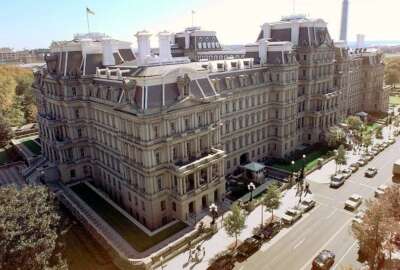
$3.1B IT modernization effort gets some legs to go with its buzz
The White House sent its legislative proposal to Capitol Hill and Rep. Steny Hoyer (D-Md.) plans on introducing legislation based on that proposal this week.
It had been years since the White House created the kind of buzz in the federal community over a technology initiative that we’ve seen over the last few months. But that’s what happened when the Obama administration announced it wanted $3.1 billion from Congress to modernize, and therefore better secure, federal IT.
There have been many doubters about the initiative, saying “It’s dead on arrival.” Or, “Why did the administration wait until now to propose something that has been needed for so long?”
Well, the concept just got some more legs late on April 8 when the White House submitted its legislative proposal for the IT Modernization Fund to Congress and a powerful House member said he plans to introduce legislation to make the fund a reality this week.
“This bill will rapidly upgrade our federal IT systems that are most in need of upgrading, either from being cybersecurity risks, inefficient, or costly to maintain,” said Rep. Steny Hoyer (D-Md.), the minority whip. “It will implement the upgrades using the latest best practices from our innovation economy in Silicon Valley and all across our country. The new upgrades will enable agencies to create new user-friendly apps and services, and will allow agencies to share data to root out fraud and abuse. The ITMF model has a proven track record in the private sector of reducing long-term costs, and I hope Democrats and Republicans can work together to advance this legislation in the weeks ahead.”
Sources say the Office of Management and Budget also is sending its troops to Capitol Hill to discuss and convince lawmakers and their staffs why such a fund is important and needed.
“Rep. Hoyer’s sponsorship of the bill in the House will complement ongoing efforts in the Senate, led by Sens. Jerry Moran (R-Kan.) and Tom Udall (D-N.M.) to move forward with the proposed Cloud IT Act,” said Mike Hettinger, a former Hill staff member and now managing principal of Hettinger Strategy Group. “We look forward to working with all interested parties on this critical issue.”
The legislative proposal from the White House outlines five underlying initiatives to change the way agencies invest and secure their systems and networks.
“We are pleased to see the administration move forward with plans to create a revolving fund that would help agencies transition off legacy IT, which remains a tremendous challenge for the federal government,” said Rich Buetel, a former Hill staff member who was instrumental in the development of the Federal IT Acquisition Reform Act (FITARA) and now is president of Cyrrus Analytics. “Shifting more government IT spend to modernization is critical and the proposed legislation is an important step in the process.”
In its proposal, the White House would give the General Services Administration the authority to oversee and manage the fund, which would act as a revolving fund where agencies would ostensibly take a loan and have to pay it back in a certain amount of time.
“Agencies either individually or hopefully multiple agencies come together and put together a business case to replace or upgrade both applications and infrastructure. They would get the funding for it and get a commitment for the funding, and then would get the actual money in increments as certain milestones are hit to encourage agile development,” said Tony Scott, the federal CIO, in an interview with Federal News Radio after a speech in March and before the legislative proposal was sent to the Hill. “Once the system goes live, they would pay that back through their operating funds so there would be in some cases cost savings, or in other cases there may not be, but whatever we do, whatever the projects are infrastructure or applications, there is a strong management commitment in terms of this is a high priority they will commit to over a certain period of time.”
A board of experts from the National Institute of Standards and Technology, the Homeland Security Department, OMB and GSA would decide on what projects should be funded, how much they should receive and what help GSA’s acquisition and technology experts could provide.
“[T]he board will identify opportunities to replace multiple legacy systems with a smaller number of common platforms, facilitating a governmentwide transition to common platforms and re-engineered business practices,” wrote Shaun Donovan, OMB director, in the transmittal letter to both houses of Congress. “Ultimately, retiring or modernizing vulnerable and inefficient legacy IT systems will not only make us more secure, it will also save money. As a means of addressing these pressing challenges, the Information Technology Modernization Fund is an important first step in changing the way the federal government manages its IT portfolio. The innovative approaches in this legislative proposal will enhance agencies’ ability to protect sensitive data, reduce costs and deliver world-class services to the public.”
Scott said the judging criteria will focus on good cyber hygiene, adoption of more modern technology and shared capabilities.
Scott said OMB is encouraging more shared applications, capabilities and infrastructure.
Knowing the reality that the current legislative session is short especially with the upcoming election, OMB, however, isn’t putting all of its IT modernization eggs in one basket.
As Federal News Radio first reported in January, OMB is developing implementation policy that would give agencies a series of deadlines to prepare for access to the fund next fiscal year.
The fact that OMB is taking a two-track process — on Capitol Hill and with the agencies — shows change is coming.
By pushing agencies down a path of doing much of the research and planning to modernize specific programs, Scott and the administration are not engaging only in wishful thinking that Congress will come up with $3.1 billion in new money or, what’s more likely to happen, rearranged spending to foot the bill of this effort.
Those who already have dismissed the fund should rethink what’s really happening here. Similarly to the E-Government Fund, when Congress rejected OMB’s $100 million request over three years back in the early 2000s, agencies continued to change the way they use technology.
So whether or not the IT Modernization Fund comes to fruition in terms of $3.1 billion or some dollar figure, agencies are heading down this path now because they have to whether or not Congress joins them.
“I think everybody recognizes the problem and we are looking for creative ways in which you can go address this,” Scott said. “I think everybody gets the age of these things is of great concern and nobody wants to throw good money after bad at the end of the day. I’m seeing a lot of good alignment around this specific issue.”
Return to the Reporter’s Notebook page
Copyright © 2025 Federal News Network. All rights reserved. This website is not intended for users located within the European Economic Area.
Jason Miller is executive editor of Federal News Network and directs news coverage on the people, policy and programs of the federal government.
Follow @jmillerWFED





